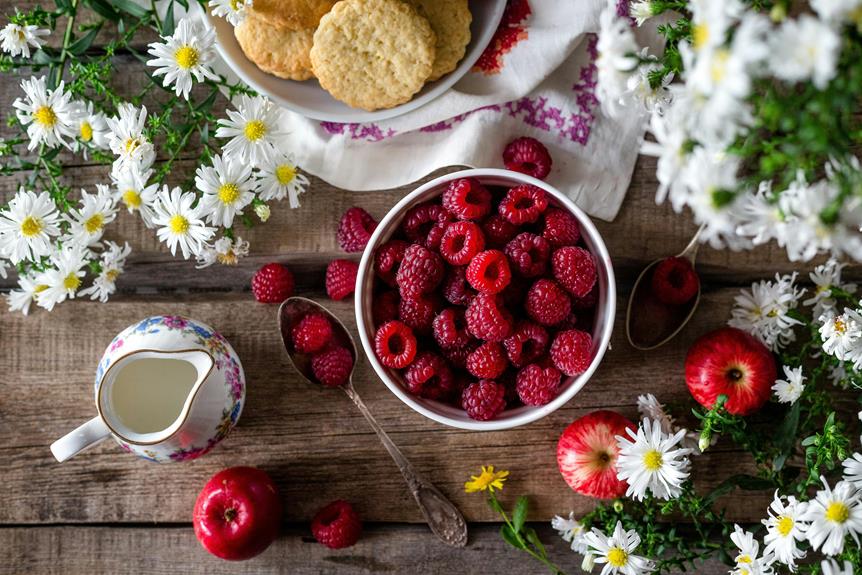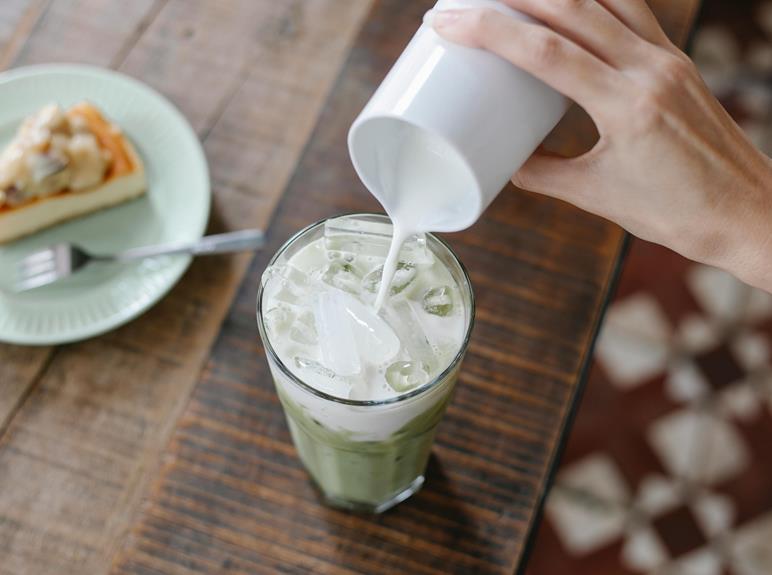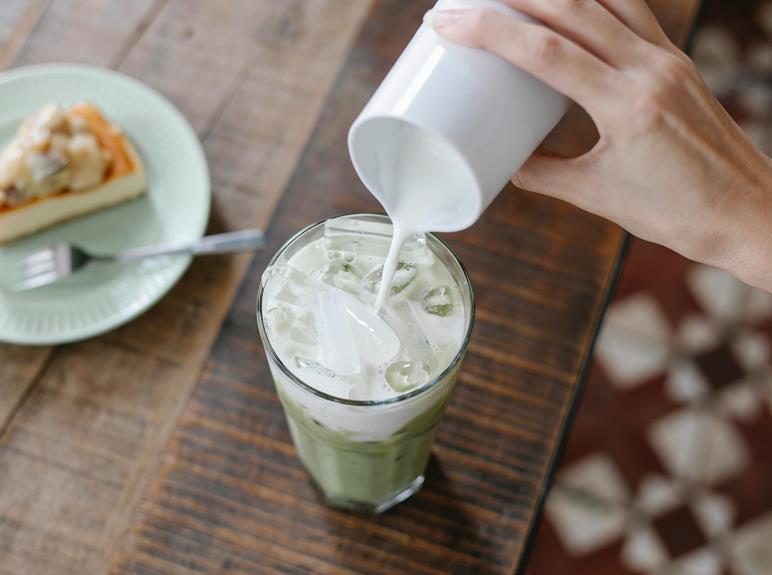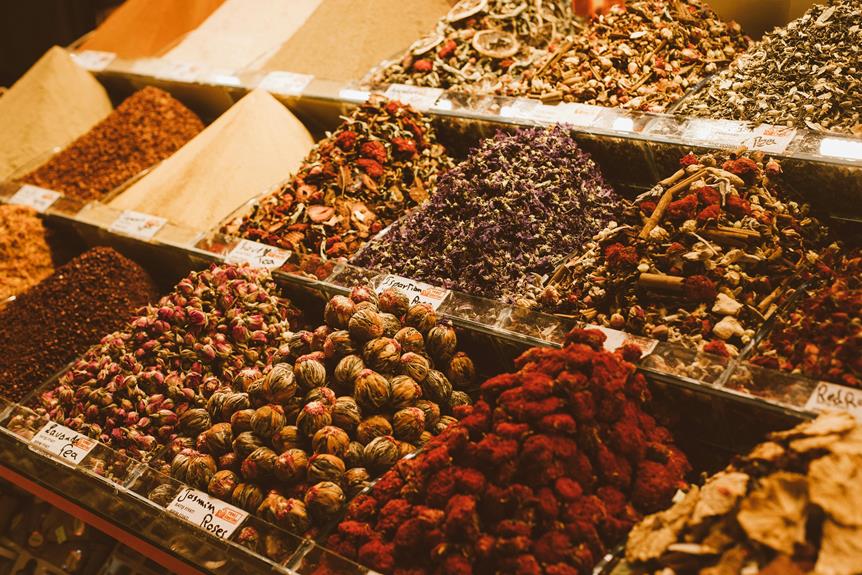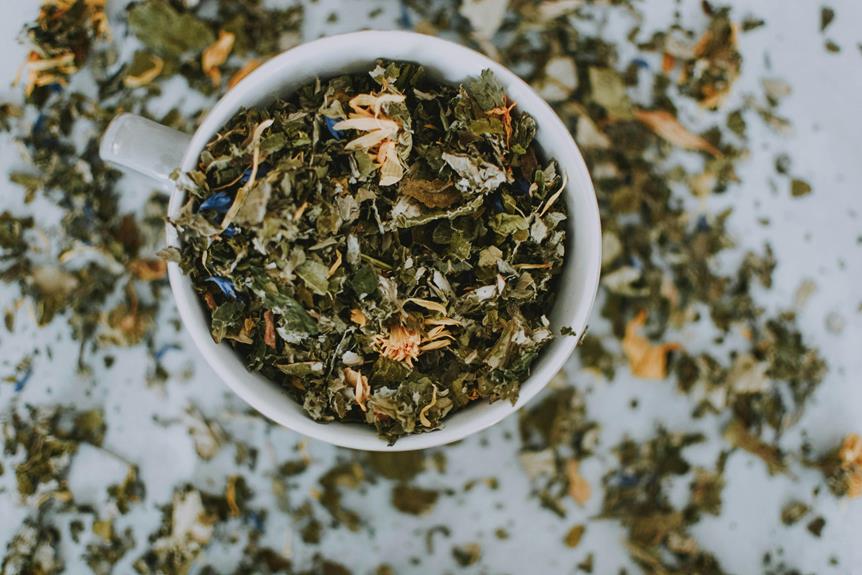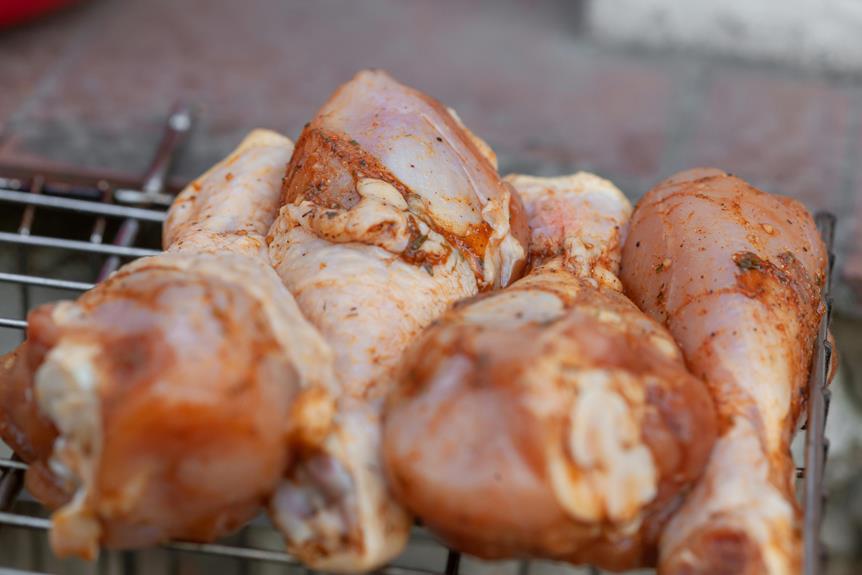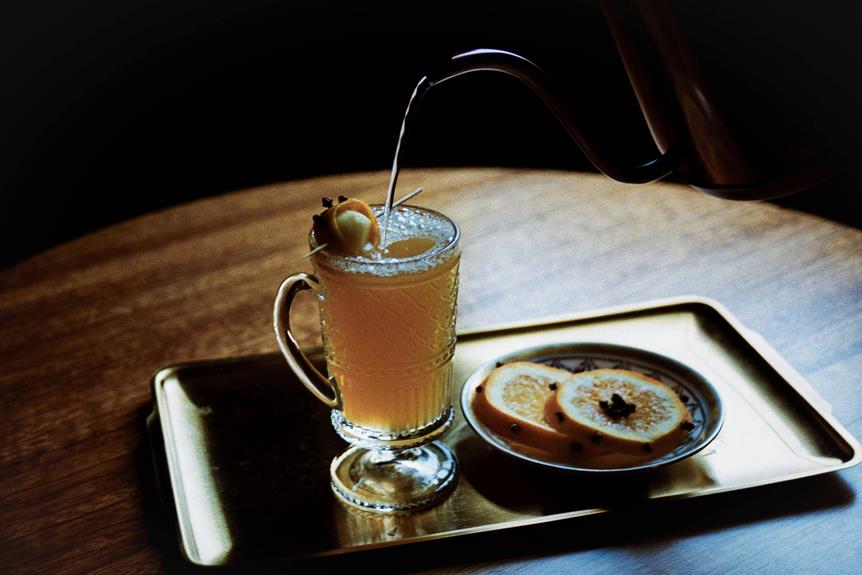You're about to discover the secret to enjoying your favorite tea blends anytime, anywhere. To make your own tea concentrates, start by selecting high-quality, robust tea varieties from renowned regions like Assam or Kenya. Experiment with brewing ratios, like 1:5 for black tea or 1:10 for green tea, to find the perfect balance of flavor and strength. Steep the leaves in a large pot, then cool the tea down quickly to prevent bitterness. Strain and filter the liquid to create a smooth, particle-free concentrate. Now, you're ready to discover the endless possibilities of flavor combinations and customizations that await you.
Key Takeaways
- Use high-quality, robust tea varieties from renowned regions like Assam, Kenya, or Sri Lanka for bold flavors and aromas.
- Experiment with brewing ratios, steeping times, and temperatures to find the ideal combination for your desired flavor profile.
- Strain and filter the tea liquid to ensure a smooth, particle-free concentrate using a fine-mesh sieve or cheesecloth.
- Cool the tea down quickly to prevent over-extraction and bitterness, using an ice bath or temperature control device.
- Customize your tea concentrates by adjusting brewing time, temperature, and adding flavor boosters like fruits, herbs, or spices to create unique blends.
Choosing the Right Tea Leaves
When brewing tea concentrates, you need to select tea leaves that can withstand high temperatures and intense flavor extraction, making high-quality, robust tea varieties the best choice.
You'll want to opt for leaves from renowned tea regions like Assam, Kenya, or Sri Lanka, which are known for their bold flavors and aromas. These regions offer ideal climates for tea cultivation, resulting in leaves that can handle the intense brewing process.
Additionally, pay attention to leaf grades when selecting your tea.
Look for higher-grade leaves, such as Orange Pekoe (OP) or Broken Orange Pekoe (BOP), which have a larger surface area and can withstand the high temperatures and pressures involved in brewing tea concentrates.
Avoid lower-grade leaves, like Fannings or Dust, as they may not hold up as well to the intense brewing process.
Selecting the Perfect Brewing Ratio
You'll need to strike the right balance between tea leaves and water to tap into the full flavor potential of your concentrates, so start by experimenting with different brewing ratios.
Don't be fooled by Ratio Myths that claim a one-size-fits-all approach. Tea Science tells us that the ideal ratio varies depending on the type of tea, desired strength, and personal taste.
For black tea, a 1:5 to 1:7 ratio (one part tea leaves to five to seven parts water) is a good starting point.
Green tea, on the other hand, typically requires a more delicate ratio of 1:10 to 1:12. If you prefer a stronger brew, you can adjust the ratio accordingly.
Remember, the key is to find the sweet spot that brings out the ideal flavor and aroma. Experiment with different ratios, take notes, and taste as you go.
With a little trial and error, you'll be well on your way to crafting the perfect brew.
Equipment Needed for Concentrate Making
Now that you've nailed down the perfect brewing ratio, it's time to focus on the equipment that'll help you turn those tea leaves into rich, flavorful concentrates.
You'll need a few essential tools to get started. First, you'll need a tea kettle that can heat water to the ideal temperature for your chosen tea type. Electric tea kettles are a great option, as they can quickly and accurately heat water to the desired temperature.
Next, you'll need an infusion tool to steep your tea leaves. This can be a tea infuser, a tea ball, or even a French press. The type of infusion tool you choose will depend on the type of tea you're using and your personal preference. Look for one that allows the tea leaves to unfurl and release their flavors freely.
Additionally, you'll need a large pot or container to brew your tea concentrate in. A heat-resistant glass or stainless steel container is ideal, as it can withstand high temperatures and won't impart any flavors to your tea.
With these basic tools, you'll be well on your way to creating delicious tea concentrates that are perfect for quick and easy brewing.
Steeping and Cooling the Tea
Steep your tea leaves in the large pot or container for the recommended amount of time, allowing the flavors to fully extract and meld together. This can range from 5-15 minutes, depending on the type of tea you're using. As the tea steeps, you'll start to notice the flavors and aromas developing.
Once the steeping time is up, it's vital to cool the tea down quickly to prevent over-extraction and bitterness. You can do this by placing the pot or container in an ice bath, which will rapidly lower the temperature. Alternatively, you can use a temperature control device to precisely monitor and adjust the temperature.
This step is vital, as it will help you achieve the perfect balance of flavors in your tea concentrate.
Straining and Filtering the Liquid
After steeping and cooling, pour the tea liquid into a separate container, leaving the solids behind to guarantee a smooth, particle-free concentrate. This step is essential for sediment control, ensuring your final product is free from unwanted particles.
To achieve this, you'll need to strain and filter the liquid. You can use a fine-mesh sieve or cheesecloth to catch any remaining solids.
For an even smoother concentrate, consider using a filter with smaller mesh sizes, like a coffee filter or paper towels.
A clear, particle-free liquid flowing into a new container
A sieve or cheesecloth catching loose tea leaves and other solids
A filter with tiny mesh sizes blocking any remaining sediment
The aroma of the tea wafting up, untainted by unwanted particles
A sparkling clean container, ready for storage or use
Determining the Optimal Strength
You'll need to test the strength of your tea concentrate by mixing it with water to find the perfect balance that suits your taste preferences.
This step is essential, as it directly affects the flavor profile of your final brew. Start by mixing a small amount of the concentrate with water, and then taste it.
If it's too strong, add a bit more water. If it's too weak, add a bit more concentrate.
Pay attention to the tannin levels, as they can greatly impact the overall flavor.
If you prefer a smoother tea, you may want to dilute the concentrate slightly. On the other hand, if you like a bolder flavor, you can use less water.
It's all about finding the sweet spot that works for you.
Storing and Preserving the Concentrate
Proper storage is crucial to preserving the flavor and aroma of your tea concentrate, so it's essential that you store it in a cool, dark place, like a pantry or cupboard. This will help prevent the growth of bacteria and mold, which can ruin the taste and texture of your concentrate.
Store the concentrate in airtight containers, such as glass jars or plastic bottles, to prevent air from getting in and spoiling the flavor.
Keep the containers away from direct sunlight, as it can cause the tea to become bitter. Avoid storing the concentrate near strong-smelling foods, as the tea can absorb odors easily.
Consider using Freezer Storage to extend the Shelf Life of your concentrate. Simply transfer the concentrate to an airtight container or freezer bag and store it in the freezer for up to 6 months.
Always label the containers with the date and type of tea, so you can easily keep track of how long it's been stored and what you have on hand.
Diluting the Concentrate to Perfection
To achieve the perfect balance of flavor, start by diluting one part of the tea concentrate with three to five parts of water, adjusting to taste. This ratio serves as a solid foundation for most flavor profiles, but feel free to experiment to find your ideal balance.
Conduct a ratios analysis to determine the perfect dilution for your specific tea concentrate. You might find that a stronger or weaker brew suits your taste buds better.
When diluting, consider the type of tea you're working with. Delicate teas like green or white tea might require a higher water ratio to prevent overpowering the subtle flavors.
On the other hand, robust black teas can handle a stronger concentrate-to-water ratio without becoming overwhelming.
Experimenting With Flavor Combinations
Now that you've found your ideal tea concentrate dilution, it's time to get creative and explore the world of flavor combinations!
You can mix and match different ingredients to create unique and delicious flavors.
Fruit infusions are a great way to add a burst of freshness to your tea. Try combining your concentrate with juicy fruits like strawberries, blueberries, or raspberries for a sweet and tangy taste.
You can also experiment with spice blends to add warmth and depth to your tea. Imagine sipping on a comforting cup of tea infused with cinnamon, ginger, and cloves on a chilly morning.
The possibilities are endless!
Mango and pineapple for a tropical twist
Lemon and ginger for an invigorating zinger
Cinnamon and honey for a soothing treat
Peppermint and chocolate for a decadent delight
Rose petals and lemon verbena for a floral and citrusy blend
Tips for Customizing Your Concentrate
With your ideal dilution ratio in hand, you can further tailor your tea concentrate to your taste preferences by adjusting the brewing time, temperature, and ingredient ratios.
Experiment with different steeping times to bring out specific tea profiles, like a stronger black tea or a more delicate green tea.
You can also play with temperature to enhance or mute certain flavors. For instance, a lower temperature might help preserve the subtle notes of a white tea.
Another way to customize your concentrate is by adding flavor boosters like fruits, herbs, or spices. Citrus peels, cinnamon sticks, or rose petals can add unique twists to your tea blends.
When combining ingredients, start with small amounts and taste as you go, adjusting the ratios to your liking.
Remember, the key to crafting the perfect tea concentrate is experimentation and patience. Don't be afraid to try new combinations and tweak your recipes until you find the perfect balance of flavors.
Conclusion
You've finally mastered the art of making your own tea concentrates – congratulations!
Now, go ahead and spend the rest of your days sipping on mediocre brews, because, let's be real, you'll never want to bother with loose leaves again.
The convenience is just too great, and your taste buds will forgive you for the slight sacrifice in flavor.
So, sit back, relax, and enjoy your quick-fix tea – after all, who needs complexity when you can have instant gratification?


